Korotkoff - Study guides, Class notes & Summaries
Looking for the best study guides, study notes and summaries about Korotkoff? On this page you'll find 741 study documents about Korotkoff.
Page 4 out of 741 results
Sort by
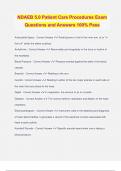
-
NDAEB 5.0 Patient Care Procedures Exam Questions and Answers 100% Pass
- Exam (elaborations) • 41 pages • 2024
- Available in package deal
-
- $13.49
- + learn more
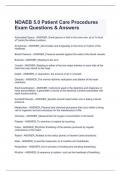
-
NDAEB 5.0 Patient Care Procedures Exam Questions & Answers
- Exam (elaborations) • 27 pages • 2024
- Available in package deal
-
- $10.99
- + learn more
Arrhythmia - ANSWER_Abnormality and irregularity in the force or rhythm of the heartbeat. Blood Pressure - ANSWER_Pressure exerted against the walls of the blood vessels. Brachial - ANSWER_Relating to the arm. Carotid - ANSWER_Relating to either of the two major arteries on each side of the neck that carry blood to the head. Depth - ANSWER_In respiration, the amount of air in a breath. Diastolic - ANSWER_The normal rhythmic realization and dilation of the heart chambers. Electr...
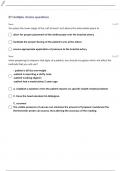
-
ATI HEALTH ASSESSMENT EXAM QUESTIONS AND ANSWERS 100% CORRECT
- Exam (elaborations) • 26 pages • 2024
-
Available in package deal
-
- $9.00
- + learn more
You place the lower edge of the cuff at least 1 inch above the antecubital space to allow for proper placement of the stethoscope over the brachial artery. facilitate the proper flexing of the patient's arm at the elbow. ensure appropriate application of pressure to the brachial artery 1 of 27 Term when preparing to measure vital signs of a patient, you should recognize which will affect the methods that you will use? - patient is 60 lbs overweight -patient is reporting a stuffy nose ...
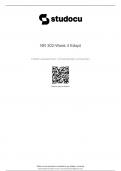
-
NR 302/NR 302-Week 4 Edapt 2023/2024
- Exam (elaborations) • 11 pages • 2024
-
- $10.49
- + learn more
Pulse rate normally varies with age, being rapid (not slow) in infancy and childhood and decreasing (not increasing) with age. The rate also varies with gender. After puberty, females (not males) have a slightly faster rate than males (not females). If a client has a high or low vital sign finding, first verify the abnormal finding by assessing the apical pulse for a full minute. Notifying the healthcare provider would occur after the finding is verified and a focused assessmen...
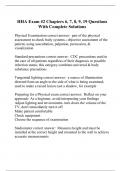
-
HHA Exam #2 Chapters 6, 7, 8, 9, 19 Questions With Complete Solutions
- Exam (elaborations) • 25 pages • 2023
-
Available in package deal
-
- $12.99
- + learn more
Physical Examination correct answer: part of the physical assessment to check body systems.; objective assessment of the patient, using auscultation, palpation, percussion, & visualization Standard precautions correct answer: CDC precautions used in the care of all patients regardless of their diagnosis or possible infection status; this category combines universal & body substance precautions Tangential lighting correct answer: a source of illumination directed from an angle to the sid...

-
Health Assessment EAQ's (JG Orig) Q&A
- Exam (elaborations) • 19 pages • 2024
-
Available in package deal
-
- $7.99
- + learn more
a common eye disorder among people over 65. It causes 1. blurred or reduced central vision, due to thinning of the macula 2. symptoms usually develop gradually and without pain. 3. Visual distortions, such as straight lines seeming bent 4. Reduced central vision in one or both eyes 5. The need for brighter light when reading or doing close work 6. Increased difficulty adapting to low light levels, such as when entering a dimly lit restaurant 7. Increased blurriness of printed words 8. D...
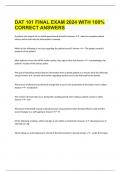
-
DAT 101 FINAL EXAM 2024 WITH 100% CORRECT ANSWERS
- Exam (elaborations) • 10 pages • 2024
-
- $16.49
- + learn more
A patient who reports for an initial appointment should be Answer - asked to complete patient history and be told why the information is needed. Which of the following is not true regarding the patient record? Answer - The patient record is property of the patient After patients review the HIPAA written policy, they sign a form that Answer - acknowledges the patient's receipt of the privacy policy. The goal of obtaining medical history information from a dental patient is to ensure all...
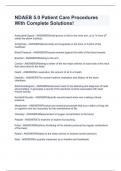
-
NDAEB 5.0 Patient Care Procedures With Complete Solutions!
- Exam (elaborations) • 29 pages • 2024
- Available in package deal
-
- $16.99
- + learn more
Antecubital Space - ANSWERSSmall groove or fold in the inner arm, at or "in front of" (ante) the elbow (cubitus). Arrhythmia - ANSWERSAbnormality and irregularity in the force or rhythm of the heartbeat. Blood Pressure - ANSWERSPressure exerted against the walls of the blood vessels. Brachial - ANSWERSRelating to the arm. Carotid - ANSWERSRelating to either of the two major arteries on each side of the neck that carry blood to the head. Depth - ANSWERSIn respiration, the amount ...
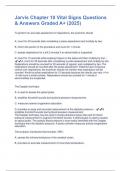
-
Jarvis Chapter 10 Vital Signs Questions & Answers Graded A+ (2025)
- Exam (elaborations) • 4 pages • 2024
-
- $7.99
- + learn more
To perform an accurate assessment of respirations, the examiner should A. count for 30 seconds after completing a pulse assessment and multiply by two. B. inform the person of the procedure and count for 1 minute. C. assess respirations for a full 2 minutes if an abnormality is suspected. D. count for 15 seconds while keeping fingers on the pulse and then multiply by four. - ️️A. count for 30 seconds after completing a pulse assessment and multiply by two. Respirations should be counte...
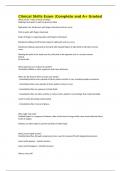
-
Clinical Skills Exam |Complete and A+ Graded
- Exam (elaborations) • 10 pages • 2024
-
- $9.89
- + learn more
Clinical Skills Exam |Complete and A+ Graded What are the 7 steps of hand washing? Rubbing hands palm to palm to generate lather Right palm over left dorsum with fingers interlaced and vice versa Palm to palm with fingers interlaced Backs of fingers to opposing palms with fingers interlocked Rotational rubbing of left thumb clasped in right palm and vice versa Rotational rubbing, backwards & forwards with clasped fingers of right hand in left palm and vice versa Rotating the ...

Did you know that on average a seller on Stuvia earns $82 per month selling study resources? Hmm, hint, hint. Discover all about earning on Stuvia


